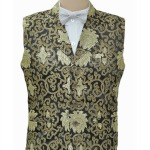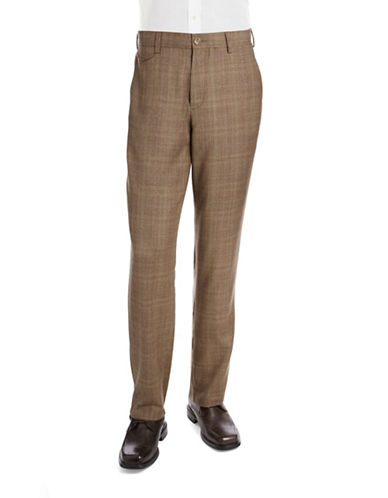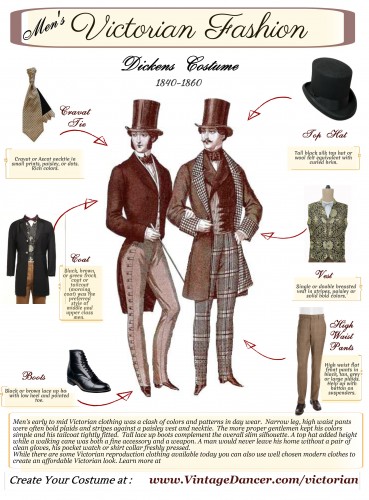
How to dress like a Victorian Gentlemen using new clothing
Living out in the Wild West, we have a lot of history that dates back to the mid-to-late Victorian era during the Gold and Silver Rushes of Northern Nevada and California. Since we have several Victorian themed reenactments to attend each year, it is essential we learn to dress the part. For men, it is not an easy task but it is doable, regardless of your budget. You can pull together a look from second hand or new clothing shops, buy new reproduction clothing, or sew your own.
This guide (and infographic above) will help you figure out the essential clothing pieces you need and how to get them within your budget.
PS. The infographic above represents an era perfect for the Charles Dickens time period. While styles did change over the 100 year Victorian era, this guide will work just as well for the 1840s as it does for the 1880s.
Victorian Men’s Hats
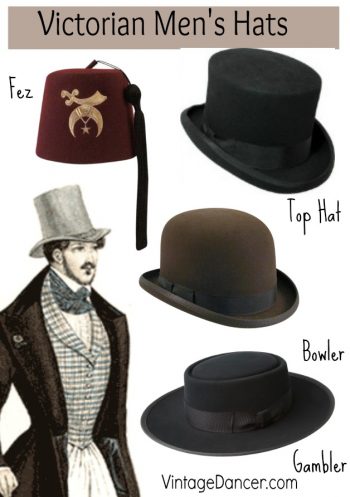
Every man needs a hat. The top hat with its tall round crown and curled side brim was the only hat a Victorian gentleman needed. Its was made of fine beaver felt that was as shiny as silk. In the later years, silk top hats were made and worn. The height of the hat went up and down in fashion year by year.
Most affordable men’s Victorian hats today are made from felt and are a happy medium height. They come in black or grey and will run about $60 plus. In a pinch, a magician’s satin top hat (costume shop) can work OK for a one time costume or event.
The Bowler hat (also known as Derby hat) came about in 1865. It had a completely round crown and curled side brims. Charlie Chaplin made them famous in later years. It was a good hat for day wear as a gentleman in town or country.
For a lower class or sporty look, try a Deer-Stalker hat (Sherlock Holmes hat) which was called a Fore N-Aft hat. A Tam o’ shanter is similar to the Blamoral cap, and the floppy newsboy cap in plaids or tweeds is another good choice. All of these hat styles are available at most men’s hat stores.
Buy Victorian style men’s hats here.
Victorian Men’s Shirt and Shirt Collar
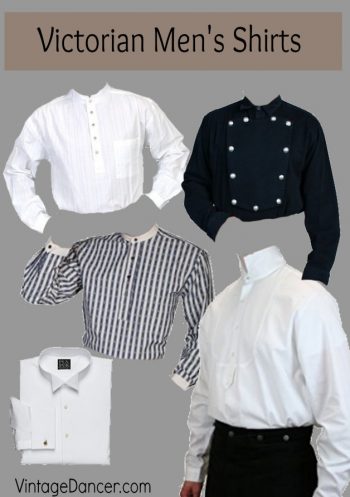 For most of the Victorian era, men’s shirts were white or off white. They were quite baggy to wear, although you would never know it since vests and coats were never taken off in good company. The shirt collar was attached and folded up around the neck. Sometimes, the tips were folded down into a wingtip design. In the 1850s, the detectable collar was invented, which saved on laundering but also introduced heavy starching to keep collars crisp and regal.
For most of the Victorian era, men’s shirts were white or off white. They were quite baggy to wear, although you would never know it since vests and coats were never taken off in good company. The shirt collar was attached and folded up around the neck. Sometimes, the tips were folded down into a wingtip design. In the 1850s, the detectable collar was invented, which saved on laundering but also introduced heavy starching to keep collars crisp and regal.
A plain button down white dress shirt with the collar folded up is all you need for most costumes. If you are going for a formal look, you can sew on ruffles or tucks in vertical rows 12 inches down from the neck. A wingtip collar shirt is another formal option and easier to buy.
Shop Victorian men’s Shirts here.
For stiff detachable collars, try Premier Clothing (order 1/2 size up for comfort). For softer collars (that you can starch to make stiffer), Gentleman’s Emporium carries several collars. In the AU, try BespokeCollars and in the UK try Classic Wardrobe or Darcy Clothing (same brand as Premier).
To sew a men’s shirt try these patterns:
Folkwear #202 for upper classes and #204 for lower classes. Laughing Moon shirt and Past Patterns are excellent as well.
Victorian Neckties
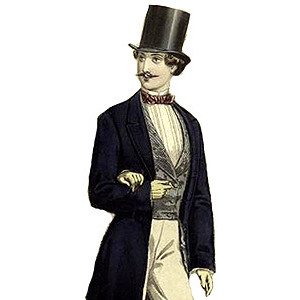
A wrapped Victorian Necktie
The necktie as we know it today didn’t come about till after the 1900s. In the Early to mid Victorian Era, men wore neckstocks tied into simple knots or a fancy ascot. White was popular until the 1840s, when black and colored silk added cheerfulness to a man’s outfit. Later in the century, plain colors turned into paisley patterns in rich jewel tones.
To make a simple Neckstock, take a 60 inch rectangle cloth and fold it several times so it is 4 to 6 inches wide. Wrap it from front to back and around to the front again. Tie it in a simple knot, a one or two sided bow, or an ascot. You can make an ascot cut tie, too.
Pre-made Ascot Cravats are nice to have and are less bulky then long pieces of cloth. They are sometimes sold where in men’s formal wear stores. Premier Clothing also carries them.
Shop ascots and other Victorian men’s ties.
Victorian Men’s Vests
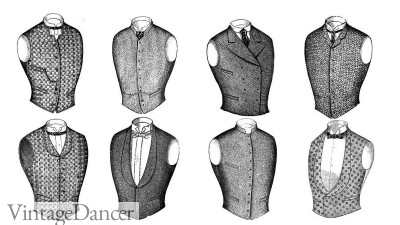
Victorian Men’s Vest Styles
Next comes a waistcoat or vest. It was often the most colorful and decorated item a man wore. It contrasted with his pants and coat, usually in lighter tones. Because men’s pants were worn high up, the vest is rather short, ending just a tad below the natural waist. It was cut straight across the bottom or with a slight bowl shape edge for portly figures. Vests were single breasted before 1850, and either single or double after 1850. It was made of wool, tweed, velvet or plain cloth for day looks and satin or brocade for evening wear. Vests had at least two pockets, one on each side, and a notched lapel collar. The lapel collar could be made of the same fabric or in a contrasting fabric (such as velvet). The round shawl collar lapel was another option that came in and out of fashion. Ties or a belt at the back were pulled tight for a very snug fit. It was the equivalent of women’s corsetry for men.
Most modern vests lack collar lapels and usually have pointed edges. In a pinch, you can sew under the points to make a straight line vest. For a better look, buy a reproduction Victorian vest such as those made by Scully Rangewear or Wahmaker. You can find these brands on Amazon.com
SEW it: Make a Victorian vest and other clothing. See this complete list. Simplicity pattern 2895 for men’s Western Victorian vests is another good source.
Shop more Victorian Men’s Vests.
Victorian Men’s Pants or Trousers
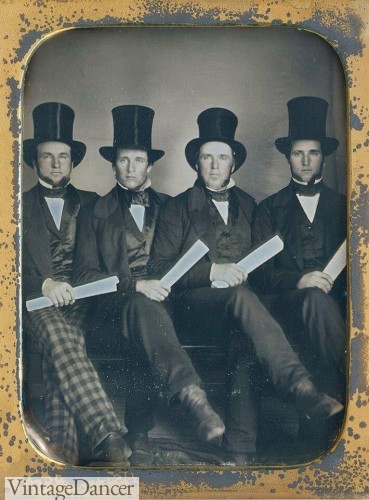
Victorian Men, solid colors and plaid pants
Initially in the 1840s, men’s pants fit tight from the high waist band down to the ankle, and were held down by a “stirrup” piece under the foot. In 1850, the stirrup piece disappeared and pants loosed up slightly, but still fitted. By 1860, the A-line, or what I call a barrel fit pant, came about. It fit very loose around the waist (held up with suspenders) and fit loose down through the leg, tapering to the ankle. Pants had fly fronts with buttons and they fit up above the navel. Colors for formal wear were black. For day wear, light grey or “fawn” (light tan) were popular. For the lower classes or dandies, vivid prints like large plaid, checks, or stripes were common. In the late Victorian years, men’s morning pants were striped but with a subtle pattern, not bold like the early years.
Most modern pants fit low — well below Victorian standards. You can remedy this by buying classic fit (not low cut) pants in a size or two up. Look for textured materials like wool, tweed or synthetics that look like wool. Use button-on suspenders to hold up your pants high. The width of the pant leg will depend on the decade you are recreating. To create a tapered look, fold the pant legs at the ankle and safety pin. Sew a tapered line if you have the sewing skills for a better look. For extra snug fitting pants, look at men’s baseball pants made of a stretch material.
Sew pants: Past Patterns has several pants for all the Victorian styles. Laughing Moon also makes a good pattern.
Shop Men’s Victorian style pants
Victorian Coats
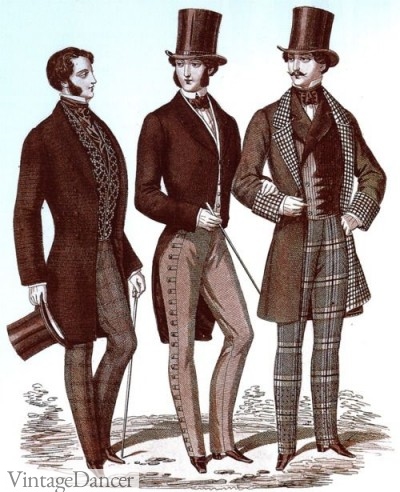
L & R- Frock coat, Middle-Tail Coat
There are four types of coats worn in Victorian times. The frock coat, the morning coat, the tail coat and the sack coat.
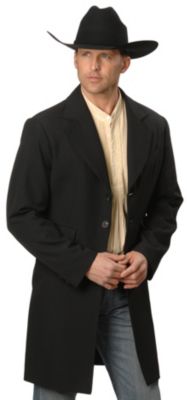
Victorian Frock Coat
Frock Coat: The frock coat replaced the tailcoat in the 1830s and remained very popular in the 1840s. It was worn off and on till the 1900s, too. It came in black, blue, brown or mulberry red. Frock coats had a form fitting single or double breasted jacket with a long skirt that fell to just above the knee. It is a style of coat that is the most difficult to find in new, modern clothing. Because it is a popular “Wild West” style, there are a few repro brands.
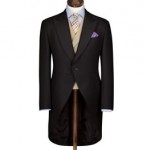
New Victorian Style Morning Coat
Morning Coat: Also called a cut away coat, it fit like a frock coat on top but the skirt was cut away from the front around to the back on an arch. It was a common day coat style starting in the mid 1850s, and is what Charlie Chaplin is famous for wearing. It was a style based on a Hunting or Riding coat, and as such it is still sold as a formal coat for equestrian competitions. Some formal tuxedo shops also still sell newer versions of the morning coat.
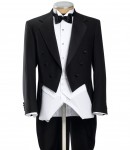
Victorian Style Tailcoat (Modern)
Tail coat: This was worn as a daycoat up until the 1830s, and afterwards was worn as a formal coat. It is still a formal coat style for white tie events and as a music conductor’s uniform. It is fitted in the waist, just like the others, but cut higher to expose an inch or so of the vest undernearth. It could be buttoned up but is often left open. The long tails in the back began at the side seams and tapered down to the back of the knee. It was always black.
Sack coat: Our modern suit coat is an updated version of the sack coat. It had no shaping at the waist like the other coat styles, and instead hung straight down to mid thigh or above with a single breasted row of buttons to hold it in place. It came about in the 1850s and gradually became the primary day coat style into 1900. It differed from modern coats by buttoning up very high, although it was common only to wear the highest buttons buttoned and the others open. It was a country look, not proper enough for city gentlemen until after 1900.
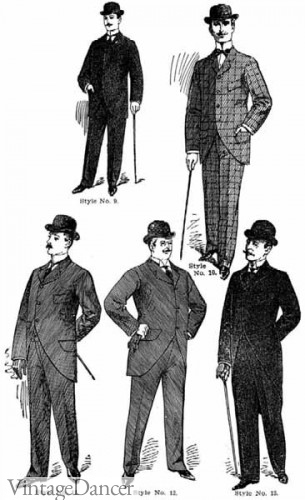
1900 Victorian Sack Coats
The front edges of the sack coat are rounded. The simplest way to turn a modern high buttoning suit coat into a sack coat is to round out the front edges (yes, sewing required). Stick to informal colors, tweed or plaids, for sack coats.
Note: Unless you can find a tailcoat at a thrift store (I did) or modify a new suit coat into a sack coat, then a Victorian coat is likely to be an expensive purchase. They are also not easy to sew if you have no experience sewing tailored menswear. Because of the expense, it is perfectly fine to not wear one. As you get into Victorian reenactements more and more, however, it will be a treat to add one to your wardrobe.
Shop Victorians men’s suits and coats:
Victorian Men’s Shoes
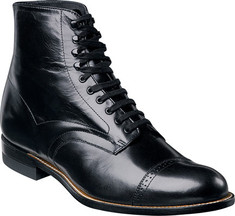
Victorian Style Boots
Men wore boots. They either buttoned up with the use of a button hook or laced up. Some also had elastic panels on the sides so they could be pulled on. Boots had pointed toes and were sometimes worn with spats over them. The ankle-length lace-up shoe came about in the later years. Today, you can find lace up boots, elastic boots (called Chelsea boots), and some mock button boots (with a zipper on the inside leg). My favorites are Stacy Adams Madison boots and shoes. With a narrow toe, cap detail and lace up style, they are identical to men’s vintage Victorian boots.
Shop men’s Victorian Style boots and shoes.
Men’s Accessories
To complete you outfit down to the last details, you’ll need just a few optional accessories:
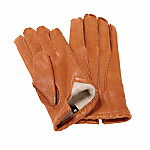
Brown Leather Gloves
Gloves: Thin leather gloves in brown for daywear or black for mourning. They button at the wrist and sometimes were lined in fur for winter. Winter is the best time to find men’s leather gloves in shops. Otherwise, cloth gloves sold at costumes shops will work ok too. White gloves were worn with strict formal attire only.
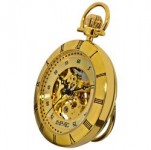
Pocket Watch
Pocket Watch: A round pocket watch on a chain, clipped to the vest and placed in one of the vest pockets. A pocket watch is an accessory that is a favorite to wear (even if its doesn’t keep time)!
Walking Cane: An ornate gold top walking cane, or ivory or wood carved short handle cane is another fun accessory. They do get annoying to carry around all day so its best to use them for short events or for photo ops.. A rolled black umbrella is another option (the old fashioned kind, not modern small collapsible types.)
Handkerchief: Practical white handkerchief should be kept tucked out of site. They were not worn as decoration in breast pockets until the 20th century.
Shop Men’s Victorian accessories.
Where to Buy Victorian Repro Clothing:
There are only a handful of companies that make repro Victorian clothing for men. Scully is the main one with lines Wahmaker and Rangewear. The line has shirts, pants, vests and coats. They are oriented to Wild West reenactors and not “gentlemen’s” clothing, however most items work for both looks.
Popular source to look at are RiverJunction, Wild West Mercantile, Sutlers (UK), Recollections and Premier Clothing.
For custom made Victorian men’s clothing, I highly recommend Mr, Allen Jeffries. I have ordered several items from him and they are extremely well made with accurate historical fabrics and trim. Another online option is Denver Bespoke.
If you want to sew your own garments, look at this big list of pattern suggestions from Wearing History or here for links to patterns.
Need help?
Feel free to contact me anytime for additional help putting together your Victorian costume.
Debbie Sessions has been teaching fashion history and helping people dress for vintage themed events since 2009. She has turned a hobby into VintageDancer.com with hundreds of well researched articles and hand picked links to vintage inspired clothing online. She aims to make dressing accurately (or not) an affordable option for all. Oh, and she dances too.
